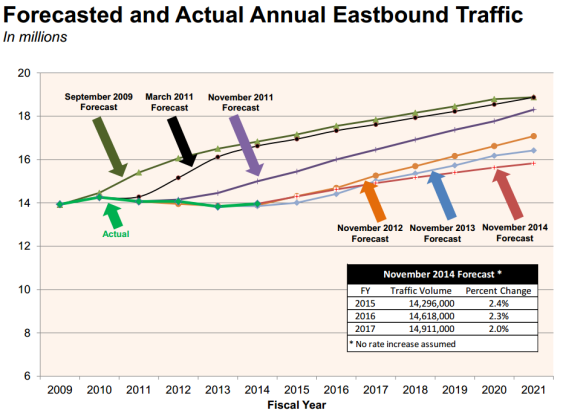The Kitsap Sun is reporting that a $1 per car toll increase on the Tacoma Narrows Bridge west of Tacoma, Washington is “close to a done deal.”
On July 1, rates will rise to $5 for Good To Go! electronic payment, $6 at the toll booths and $7 for pay-by-mail. A déjà vu will occur one year later.
WSDOT believes that if tolls on the bridge don’t rise, there’s a good chance that the state won’t have enough tolling revenue to cover the financing costs for the $728 million second span, which was opened to the public in 2007. Tolling shortfalls, in turn, could force WSDOT to dip into general transportation funds for a project that was supposed to pay for itself.
As the chart below shows, traffic across the bridge has consistently failed keep up with the forecasts. Traffic has been basically flat: despite a modest uptick in 2014, actual traffic volumes (the thick green line) are still about the same today as in 2009.

TNBCAC presentation, p. 17 by WSDOT
Yet the agency’s current “best” guess (the red line) remains remarkably similar to the one they made back in 2009: despite all evidence to the contrary, they assume traffic will soon begin a steady ascent. They’re counting on it, in fact, because without steady growth, bridge tolls might not bring enough revenue enough to pay back the bridge’s financing costs.
In short, the agency seems to view the modest traffic uptick in 2014 as the “new normal,” rather than as a short-term boost caused by low gas prices. Indeed, the monthly data shows that traffic was flat through the middle of 2014: it was only when gas prices fell in earnest that year-over-year traffic volumes started to rise in earnest. Still, WSDOT seems to view a few months’ worth of data as evidence that endless traffic growth is here to stay.
Yet to my eyes, WSDOT’s rosy traffic forecasts ignore the impact of higher tolls. The toll increase is steep: 22 percent over 2 years, reaching $5.50 for every round trip across the bridge. And if history is any guide, a toll increase of this magnitude is likely to suppress traffic growth.
In short, it’s possible that higher tolls will keep the Tacoma Narrows bridge stuck in the “tolling death-spiral,” where higher tolls suppress traffic growth, causing tolling revenue shortfalls, which in turn necessitate even higher tolls to raise enough money to cover debt payments. And if the bridge does wind up trapped in that vicious circle, the real culprit will be the traffic forecasters—the ones who based the financial plans for the bridge on optimistic but deeply flawed projections of endless traffic growth.








Ann Dasch
Hey Clark – thanks for getting this out so quickly.
I’ve been trying to find TNB traffic stats from the time before the new bridge opened. Have you seen that anywhere?
Ann Dasch
What most concerns me about the state’s traffic forecasting model is that they do not appear to consider trips per household per year in their projections. Tolling raises the cost of living a LOT for commuters but only a little for retirees and vacation home owners. Since affordability is the biggest factor in where people choose to live, increasing tolls would tend to nudge high bridge use households to move away. As they are replaced by low use households, the trips per household go down, so even though more homes are built, traffic could stay the same or decline. This has been happening in ferry dependent communities for years.
Clark Williams-Derry
That’s an excellent point, Ann! More generally, forecasts of the usage of toll roads are always more troublesome than forecasts for other roads. Transportation planners tend to underestimate
* the potential for diversion to other facilities (less relevant for the TNB, because there are no other facilities),
* the fact that many households change their habits to avoid paying tolls, and
* the fact that some households actually factor toll costs into their decisions about where to live and/or work — which, over the long haul, can gradually dampen demand.
These problems all exacerbate the tolling death-spiral—where toll rates have to go up faster than expected or hoped, which further dampens demand, which requires more toll hikes. Lather, rinse, repeat…and you have the potential for substantial and unexpected public subsidies for a project that was supposed to “pay for itself.”
Ann Dasch
Apart from the tolling death spiral, is the social engineering problem. West sound communities are “graying” faster than the Puget Sound region and WA state – in part because younger folks are pushed out by high tolls. West sound communities have declining school enrollments but burgeoning demand for senior services and medical care. Meanwhile many school districts east of Puget Sound are growing faster than they can build (or pass school bond measures) and traffic over here is rapidly worsening. But you can cross the Narrows at 60 mph even during the peak commute now, so according to WSDOT so the new bridge was a good investment!
Winfield
Another piece the traffic forecasters seem to miss is the change in reasons people cross the bridge. New expanded medical facilities have opened on the Gig Harbor side. More shopping opportunities have come to that side of the bridge – along with an increase of on-line shopping. When you can ship for free or less than the toll, why go to the malls in Tacoma? You are also likely to combine errands as the tolls go up, and become more efficient, which is bad for the tolls.
Just for argument – if you have to commute, and make say $10/hr … you have spent 30min of your workday just to pay to cross the bridge.
Ann Dasch
The latest: http://www.thenewstribune.com/2015/04/24/3757009_critics-take-aim-at-narrows-bridge.html?rh=1